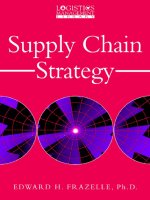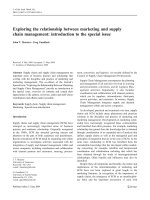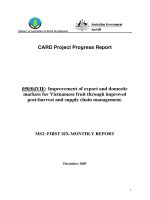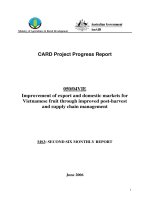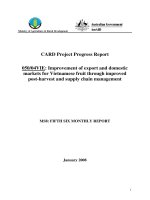APPLYING BLOCKCHAIN TECHNOLOGY IN LOGISTICS AND SUPPLY CHAIN MANAGEMENT
Bạn đang xem bản rút gọn của tài liệu. Xem và tải ngay bản đầy đủ của tài liệu tại đây (1.1 MB, 125 trang )
MINISTRY OF EDUCATION AND TRAINING
FOREIGN TRADE UNIVERSITY
MASTER THESIS
APPLYING BLOCKCHAIN TECHNOLOGY IN
LOGISTICS AND SUPPLY CHAIN MANAGEMENT
Specialization: International Trade Policy and Law
TA KHANH LINH
Hanoi – 2020
MASTER THESIS
APPLYING BLOCKCHAIN TECHNOLOGY IN
LOGISTICS AND SUPPLY CHAIN MANAGEMENT
Specialization: International Trade Policy and Law
Code: 8310106
Full name: Ta Khanh Linh
Supervisor: Dr. Vu Thi Hanh
Hanoi - 2020
ii
i
DECLARATION
I, Ta Khanh Linh, confirm that this Master's Thesis has been written
solely by the undersigned and contains the work of no other person or persons
except where explicitly identified to the contrary.
I also state that said Master's Thesis has not been submitted elsewhere
for the fulfilment of any other qualification.
I make this statement in full knowledge of and understanding that,
should it be found to be false, I will not receive a grade and may face
disciplinary proceedings.
Signature:
Date: 23 March 2020
ii
ACKNOWLEDGEMENTS
I would like to express my special thanks of gratitude to my supervisor
Dr. Vu Thi Hanh as well as our principal, Faculty of Graduate Studies and all
professors of Foreign Trade University who gave me the golden opportunity
to do this wonderful project on the topic “Applying blockchain technology in
logistics and supply chain management”, which also helped me in doing a
lot of research and I came to know about so many new things I am really
thankful to them.
Secondly, I would also like to thank my parents and friends who helped
me a lot in finalizing this project within the limited time frame.
TABLE OF CONTENTS
Page
DECLARATION...................................................................................................... i
ACKNOWLEDGEMENTS.................................................................................... ii
LIST OF ABBREVIATIONS.................................................................................. v
LIST OF FIGURES............................................................................................... vii
LIST OF TABLES................................................................................................ viii
ABSTRACT............................................................................................................ ix
CHAPTER 1: INTRODUCTION........................................................................... 1
1.1. Statement of the Problem............................................................................... 1
1.2. The Purpose of the Study................................................................................ 2
1.3. Research Questions........................................................................................ 2
1.4. Thesis Structure.............................................................................................. 3
1.5. Methodology.................................................................................................. 4
1.5.1. Research Design...................................................................................... 5
1.5.2. Data Collection........................................................................................ 6
CHAPTER
2:
LITERATURE
REVIEW
AND
THEORETICAL
FRAMEWORK..................................................................................................... 13
2.1. Background Knowledge............................................................................... 13
2.1.1. History of Logistics and Supply Chain Management............................13
2.1.2. What is blockchain technology and How does it works?......................16
2.2. Blockchain Applications in Financial Areas................................................. 25
2.2.1. Bitcoin - Cryptocurrencies.................................................................... 25
2.2.2. Investment sector................................................................................... 31
2.2.3. Insurance sector..................................................................................... 32
2.3. Blockchain in non-financial areas................................................................. 33
2.3.1. Smart contracts...................................................................................... 33
2.3.2. Intellectual Property.............................................................................. 37
2.3.3. Politics and E-voting............................................................................. 44
2.3.4. Other sectors..........................................................................................46
2.4. Blockchain in Logistics and Supply Chain Management.............................48
2.4.1. Potential blockchain applications in the logistics and supply chain
industry.................................................................................................. 48
2.4.2. Transformation phases of blockchain applications in logistics..............52
2.5. Conclusion.................................................................................................... 56
CHAPTER 3: ANALYSIS AND FINDINGS....................................................... 58
3.1. Case study analysis....................................................................................... 58
3.1.1. Walmart and the using of IBM Hyperledger Fabric in Food Supply Chain
..........................................................................................................................58
3.1.2. Maersk’s TradeLens with IBM ..............................................................63
3.1.3. Everledger’s blockchain secure luxury goods.......................................68
3.1.4. SmartLog - the proof of concept project for IoT blockchain solution in
logistics industry.................................................................................... 73
3.1.5. Some others adoption of blockchain to logistics and supply chain
management projects............................................................................. 76
3.2. Case studies summary.................................................................................. 77
3.3. Discussion on the achievements and remaining concerns of the case study
projects......................................................................................................... 80
3.4. Blockchain Features Tradeoffs in Supply Chain Management.....................83
3.5. Challenges and Possible Solutions............................................................... 85
3.6. Conclusion on the future of blockchain in logistics and supply chain
management.................................................................................................. 94
CHAPTER 4: DISCUSSIONS AND CONCLUSIONS....................................... 96
4.1. Discussions................................................................................................... 96
4.2. Limitations and future research.................................................................... 97
4.3. Conclusions.................................................................................................. 97
REFERENCES......................................................................................................99
v
LIST OF ABBREVIATIONS
3PL
- Third party logistics
4PL
- Fourth party logistics
AIR
- Applied Innovation Review
API
- Application Program Interface
APS
- Advanced Planning and Scheduling
ASIC
- Application Specific Integrated Circuits
BCO
- Beneficial Cargo Owner
BEV
- Blockchain-enabled E-voting
BFT
- Broadcast File Transfer
BIPS
- Europe’s primary bitcoin payment processor for
merchants and free online wallet service
CEO
- Chief Executive Officer
CLM
- Council of Logistics Management
CSC
- Connected Supply Chain
DAO
- Decentralized Autonomous Organization
DHL, BMW, IBM, APL - name of enterprises
ERP
- Enterprise Resource Planning
EVM
- Earned Value Management
FARC
- Revolutionary Armed Forces of Colombia
FTU
- Foreign Trade University
ICO
- Initial Coin Offerings
ID
- Identification
IoT
- Internet of Things
IP
- Intellectual Property
ISO
- International Organization for Standardization
IT
- Information Technology
JIT
- Just in Time
LCC
- Low-Cost Carrier
MNC
- Multinational Company
NFC
- Near Field Communication
PBFT
- Practical Byzantine Fault Tolerance
PC
- Personal Computer
PIL
- Pacific International Lines
PoC
- Proof of Concept
PoW
- Proof of Work
PoS
- Proof of Stake
R&D
- Research and Development
ROI
- Return on Investment
SCM
- Supply Chain Management
TC
- Technical Committee
TCT
- Transaction Confirmation Time
TPS
- Transactions Per Second
TTP
- Trusted Third Party
WTO
- World Trade Organization
LIST OF FIGURES
Page
Figure 2.1: A history of blockchain technology.......................................................19
Figure 2.2: Blockchain example..............................................................................20
Figure 2.3: Illustration of a blockchain transaction..................................................21
Figure 2.4: Benefits of Blockchain..........................................................................24
Figure 2.5: Buying a house on Ethereum.................................................................36
Figure 3.1: Foods Walmart is Tracking with Hyperledger.......................................60
Figure 3.2: IBM Blockchain for Trade logistics......................................................65
Figure 3.3: TradeLens blockchain business network...............................................67
Figure 3.4: Globally connected via API...................................................................70
Figure 3.5: Simplified decision tree for identifying blockchain use cases...............92
Figure 3.6: The steps for a blockchain implementation...........................................93
LIST OF TABLES
Page
Table 2.1. Potential blockchain applications in the logistics industry......................52
Table 2.2. Transformation phases of blockchain applications in logistics................53
Table 3.1: Case studies’ status summary..................................................................78
xi
ABSTRACT
This paper is an intensive research paper under the Master Thesis of
International Trade Policy and Law program at Foreign Trade University
(FTU). The main subjects of this topic are blockchain technology, logistics
and supply chain management industry. The purpose of this paper is to
introduce and analyze case studies about how blockchain technology is
applied in the logistics and supply chain management sector.
Logistics and supply chain management process play an important role
in the international trade area. Nowadays, these two concepts appear in almost
every aspect of the trading and production process. Companies use logistics
management to plan, control, and implement procedures for the effective and
efficient storage and transportation of goods, tracking the products from the
point of origin to the point of consumption. Supply chain management helps
organizations to manage the flow of goods and services and includes all
processes that transform raw materials into final products.
In order to utilize the benefits of logistics and supply chain management
in international trade, businesses started to think of adapting technology for
them, including information technology, communication technology, and
automatic identification technology. Improved technology has increased
productivity in the supply chain, minimizing costs and errors. Technology is
an effective tool to enhance supply chain competitiveness and performance by
enhancing the overall effectiveness and efficiency of the logistics system.
Moreover, various innovations in technology have made the task easier and
faster besides being less laborious.
Blockchain technology is one of the innovations that are considered to
change the way how logistics and supply chain management work. One
lingering problem of modern logistics and supply chain is a lack of
transparency between buyers and manufacturers. There is still a lot of
miscommunication between vendors and suppliers, as well as difficulties in
tracing each stage of deliveries. Luckily, blockchain technology is here to
solve this challenge.
Understanding the potentials of blockchain in the field of logistics and
supply chain management and its future in international trade, the author has
decided to make a research paper about the topic: “Applying blockchain
technology in logistics and supply chain management”.
The thesis paper contains 4 chapters that aim to answer the main
statement of the problem: “What kind of inefficiencies can be managed with
blockchain in the field of logistics and supply chain management and what
are the barriers and challenges, and the prediction of the technology?”, with
four sub-research questions. The paper begins with an introduction that
includes some of the background information that is intended to inform the
reader. Following that section, a number of literature reviews and case studies
will be introduced and analyzed to give a conclusion of the blockchain
adoption process in the logistics and supply chain management sector. Finally
a summary will connect all the information in a concise manner.
13
CHAPTER 1: INTRODUCTION
1.1. Statement of the Problem
Blockchain is an emerging technology in the business world, especially
in the logistics and supply chain management area because of its huge
benefits. Blockchain may bring many opportunities for the development of
the logistics and supply chain management due to the potential to lower the
operating costs, boost the service quality, and consequently improve the
organization and the entire supply chain competitiveness. However,
blockchain adopters meet many challenges on their way of bringing this
technology to the world.
In theory, the blockchain can become the technological answer to solve
many current problems in logistics and supply chain sectors, but it is very
hard to change and adapt. It is not very easy to insert a new technology inside
established supply chain systems because the integration challenges are not to
be underestimated (Mougayar, 2016, 123). Already many projects are
underway to apply blockchain technology to global logistics, adding value by
boosting supply chain transparency and automating administrative operations.
It can be named several standing out projects such as Everledger, SmartLog,
and DHL-BMW Proof of Concepts (PoC). These on-going projects are
operated differently in many ways, but they all have the same purpose to find
solutions for the problems of modern logistics and supply chain management
in the 4.0 industry context. Addressing these projects and their operating
status will have practical benefits for the future of the logistics and supply
chain management sector, and contribute to the understanding of this
widespread application.
At the end of this paper, it is expected to give an overview of the
applying status of blockchain technology in the field of logistics and supply
chain management and answer a part of the lingering question: What kind of
inefficiencies can be managed with blockchain in the field of logistics and
supply chain management and what are the barriers and challenges, and the
prediction of the technology?
1.2. The Purpose of the Study
This study aims to go deeply in the application of blockchain in the
logistics and supply chain management by examining various literature
review provided in chapter 2 and the existing use cases introduced in chapter
3 to present the value propositions of blockchain in supply chain and logistics
and several challenges of this technology. After that, some recommendations
for adaptors and predictions for the future of blockchain technology in
logistics and supply chain management will be represented.
1.3. Research Questions
The research will be based on the status of logistics and supply chain
management industry, and the application of blockchain technology to the
field. As mentioned, the main goal of the thesis will be to evaluate the
possibility of applying the blockchain in logistics and supply chain
management. It will further be based on some case studies of several projects
on applying blockchain in this industry.
To be able to answer the problem statement, it has been seen necessary
to use a couple of research questions, in order to get around the problem area
and being able to answer the problem statement, in the best possible way.
The following research questions have been seen necessary in order to
answer my problem statement in the best way:
Question 1: How has blockchain been adopted in logistics and supply chain
management?
Question 2: What are the challenges of applying blockchain in logistics and
supply chain management?
Question 3: How could enterprises adopt better the technology and overcome
the challenges?
To answer research question 1, a literature review will be given to
explain the purpose of applying this technology to the field of logistics and
supply chain management and the way it works. After that, several on-going
projects will be discussed in details for a better view of the current status and
the adoption trend in the world.
Research question 2 will be answered by a summary of the literature
review and the current status of these mentioned projects about applying
blockchain technology in logistics and supply chain management to give out a
list of the challenges when logistics and supply chain management apply the
new blockchain technology.
The research question 3 will be answered by some recommendation from
the experiences of the mentioned cases for future projects in this area and a
prediction for blockchain’s future in logistics and supply chain management
industry.
The gathered information from the literature study and the case study
will then be the base of the application in logistics and supply chain
management.
1.4. Thesis Structure
The paper will be divided into 4 chapters, including Introduction,
Literature Review and Theoretical Framework, Analysis and Findings, and
Discussion.
Chapter 1 will focus on the purpose of the thesis, and then introduce the
problem statement and the research questions developed from it. Chapter 1
will also give an overview of how the research design is built and the
methodology used. The methodology will introduce to the readers the overall
approach and full details of data collection methods. In chapter 2, a
literature review and
theoretical framework will be given after analyzing the published sources on
the main subjects of blockchain and its applications that already been used in
real life contexts. Based on the thesis objectives, a number of literature will be
reviewed for the references of the given topic Not all of the literature review
will have the same importance of the papers further development, but in order
to give a good overview and understanding and perspective on the subject, it
has been needed to include anyway. The main purpose of the literature review
is to make a foundation for the case studies about on-going projects that
applying blockchain technology in logistics and supply chain management.
Chapter 3 will deeply analyze the list of case studies about on-going
projects that applying blockchain technology in logistics and supply chain
management. These projects’ achievements and remained problems will be
summed up for a conclusion of the current state of blockchain technology in
the logistics and supply chain management industry.
Chapter 4 will be the discussion in which the author discusses the results
and conclude on the study’s findings, the findings in relation to the statement
of the problem, and the research questions that were identified. This chapter
also brings up the limitations or weaknesses of the study’s design or findings
and some recommendations for future areas of research that should be
conducted related to my study, actions, policies, or procedures related to the
study’s findings. The final part will identify the critical conclusions about the
study and its implications.
1.5. Methodology
The methodological approach will influence the shape of the study, the
data collection, and data analysis. This will also affect the focus and role that
the literature study of the assignment will have in the later research.
There are two common alternative ways of relating theory to reality,
which are the deductive and inductive approach. The inductive approach can
be described as an explorative way where the goal is to generate theory. This
research approach seeks to understand, interpret and totalize, and goes from
empiric study to theory (Saunders 2007 p. 117). The deductive approach on
the other hand, focuses on testing existing theories by developing propositions
from current theories, and making them testable in the real world (Saunders
2007 p. 118). Although these are two different research approaches, it is also
possible to combine them, which often is seen as an even better and
advantageous way, to draw conclusions on a research process (Saunders
2007).
Both deductive and inductive approach will be used in order to draw the
final conclusions. I therefore see it as an advantage to using both of the
methods, as the thesis first will be testing the theory, but then from the results
building a new theory. The analysis of the case study will therefore be based
on the deductive approach where “testing theory” will be done, and the
inductive approach will be used when the risk management strategy is created
also called the “theory building”.
1.5.1. Research Design
This section will give an introduction to how the design of the research
will be, and discuss the methods relevant for this project, so the reader can
understand how the thesis has been developed throughout the literature and
the qualitative data gathered.
The paper takes its starting point with the problems and the general
problem area in terms of blockchain applications in the logistics and supply
chain management industry. A literature study and relevant theory regarding
the topic will then be introduced, and used on a number of case study projects.
The gathered information from the literature study and the case study
will then be the foundation of the strategic adoption of blockchain, which will
be developed for companies applying this new technology in their operation,
and
be prepared for the changing of logistics and supply chain management in the
soon future.
The assignments research design is combined with primary and
secondary data, in terms of a case study and literature study. The primary
source for the empirical study of the assignment will be the author’s
observation of the case project. On the other hand, the secondary data will be
gathered from company reports and scientific articles to form the scientific
and theoretical approach of the paper.
According to Andersen 2006, there are three types of research methods;
quantitative or qualitative, or a combination of both of them. Andersen 2006
argues for, that the main difference between quantitative and qualitative
research is the use of numbers. Quantitative research is mostly based on facts
and study relations between sets of facts. Qualitative data on the other hand, is
based on all other information than numbers, such as movies, photos, objects,
etc. (Andersen 2006 p. 150). The goal with the qualitative data is to get an
insight instead of statistical analysis. Common ways to do qualitative research
is through interviews and observations where for quantitative is through
surveys.
This study is performed by using a qualitative method and by conducting
deeper investigations into a number of case studies by testing previous
research. The qualitative research that is performed in this thesis will be based
on the interview with the case company representatives and experts, and the
goal is to get a more in-depth study by using this method.
1.5.2. Data Collection
There are two categories of information which can be collected during
the study, which are divided between primary and secondary data. Primary
data can be gathered through interviews and observations, where the
secondary data is however already existing data within areas, where
research is being done
(Andersen 2006 p. 47). The secondary data is already existing data can be
gathered through the internet, literature of scientific journals. This thesis will
be based on both primary data and secondary data. The next part will give a
description of how and which sources have been used to gather the necessary
information of the thesis.
Primary data
The empirical study of this thesis is based on a number of case studies of
the blockchain adoption in logistics and supply chain management. The
chosen research strategy is described as the strategy type of “the multiple case
study” by Yin (2003), in which a list of open questions (who, what, how, and
why) will be designed for each case. There is not any direct control over
situations as by using the open questions, the answers given will be based on
current and past situations in relation to the projects towards logistics and
supply chain management (Yin 2003). As there is being analyzed on “case
study” it is important to define what this phenomenon means.
Yin 2003 defines this in the following two citations:
“A case study is an empirical inquiry that investigates a contemporary
phenomenon in depth and within its real-life context, especially when the
boundaries between phenomenon and context are not clearly evident.
[...] The case study inquiry copes with the technically distinctive
situation in which there will be many more variables of interest than
data points, and as one result relies on multiple sources of evidence,
with data needing to converge in a triangulating fashion, and as another
result benefits from the prior development of theoretical propositions to
guide data collection and analysis” (Yin 2003 p. 13).
The goal of the case studies is to understand, how the case-projects have
applied blockchain in the field of logistics and supply chain management, and
what approaches and actions towards have been taken (Yin 2003 p. 41).
The paper’s findings are characterized by several cases (i), where there
will be performed the research and observation (ii), where the goal is to create
an understanding of the case organizations approach, and possible strategy
towards the adoption (iii). It can be argued that the sources of primary data
with the cases might not be in-depth enough in relation to helping with
answering the problem statement of the thesis. The possibility was though
there to get more observations, but I am convinced that more observations
would have given more valuable information, as the observation was
performed after the literature study was performed, and therefore I had a basic
goal of what I wanted to get answered. I therefore argue and assess, that the
research and observation are enough to cover the needed information to help
with the answering of the problem statement.
The process of the structuring of the data material about the case
organization will be seen as the “flexible case design” (Yin 2003 p. 62), as the
flexible case design will allow the observation to be adapted to the path of the
research. This will also allow potential unexpected and important information
to be included, in the gathered data from the observation.
It has not been possible to follow the cases in a long-term period, which
means that the empiricism from the observation is based on historical data,
which forms the basis to achieve data of incidents, and events occurred before
the start of the case studies.
The empirical data gathered from the case studies cannot completely be
seen usable to be compared to all global and MNC’s adoption of blockchain
as this would need more cases on the same topic and same type of
organization to conclude on (Andersen 2006 p. 139-142). The goal of the
primary sources is to structure the case studies, find the relation between the
literature studies, be able to analyze the data gathered, and follow a
conclusion to the research questions and problem statement.
Secondary data
Secondary data include both quantitative and qualitative data and are
used principally in both descriptive and explanatory research (Saunders
2007). The secondary data can be based on journals, letters, TV programs,
reports, and articles, etc. (Andersen 2006). The secondary data used for this
thesis is mostly based on scientific papers and journals found through the
school database, by searching for specific topics.
Information found on the internet, the case companies’ homepages
especially, has also been useful for secondary data, about the general
information of the projects. A list of companies’ annual reports has also been
used for information about the projects to give a picture of the adoption
process. Different reports on the topic have also been used as they also give a
different view compared to the scientific view. The supervisor’s corrections,
comments, and suggestions have also been taken into account throughout the
process of the thesis.
The analysis will connect the existing theories with my research and
observation to conclude on the current state of the blockchain adoptions in the
logistics and supply chain management industry.
The focus will be on giving recommendations and create an overall
strategic adoption management framework that can be used by the case
organizations and other similar companies, operating in the same
environment.
Verification and generalization of empirical data
The quality of the empirical data throughout the thesis should be secured
with a high validity and reliability. The empirical data are mostly developed
by the observation of multiple case studies and gathered from information that
already available such as scientific papers and the annual report of the
organization. It is also important to state in which degree the results of the
multiple case study can be generalized for other companies and organizations.
Validity
The validity in this thesis refers to establishing the domain to which a
study’s findings can be generalized, when doing the case studies (Yin 2003 p.
34). The term covers the relationship between validity and relevance, where
the validity is about the general accordance between the theoretical and
empirical perception plan, with the relevance concerning the fact on, how
relevant the empirical selection is for the problem statement (Andersen 2006
p. 81).
The terms also have a different meaning depending on whether the
research is qualitative or quantitative. In a qualitative study validity means
that there has to be conformity between the researcher’s observations and the
conclusion drawn. In quantitative research, validity means congruity between
the statistic result and reality. Conducting qualitative research will always
have the risk of subjectivity and the empirical results will therefore be
affected by my interpretation of the respondent’s description of the reality
(Kvale 2006 p. 231).
The research needs to be secured validity. This means that the research
should be trustworthy, valid and that the questions answered in the project are
relevant. I should be clear and confident about the findings to answer the
research questions developed. Therefore the quality of the result depends on
how similar it is to the phenomenon that I want to investigate (Kvale 2006 p.
231). When performing an observation like in this research it is important to
notice the possibilities that exist, where the information could be company
sensitive.
For the secondary data, there have been done a big effort in using
literatures that concern the thesis’s main subject of blockchain applications to
secure a high validity of the secondary data from scientific journals and reports
from companies with experience within the topic.
Reliability
Reliability refers the demonstration of the operations of a study, like the
data collection procedures can be repeated, with the same results (Yin 2003 p.
34). The reliability of a study is affected by the way the research is carried
out, the researcher’s precision and attention during the processing of the
gathered information (Andersen 2006).
In this thesis the reliability has been sought by having a number of case
study projects in the field. Naturally the reliability could have been even
higher if it could have been supported by performing a multiple case study, by
having more companies with same type of operations observed and getting
their experiences of adopting blockchain in logistics and supply chain
management added to the research. A quantitative research by adding a survey
where a larger amount of companies answering could further have been made,
but haven’t seen very useful, in terms of the thesis needing some more in
depth answers, in terms of different experiences compared to a survey.
Generalization of case study results
The generalization of the case study design has often been criticized and
many authors have seen the case study design as unscientific. The method
has, although it is extended, been very little involved in method literature
(Andersen 2006 p.115). Andersen though thinks and assesses the case study as
very crucial and important, when doing scientific studies. According to Yin
(2003), there are two categories of generalizing results from case study to
theory: analytic generalization and statistical generalization. Analytical
generalization relies on case studies (as with experiments) where previously
developed theory is used as a template with which to compare empirical
results of the case study. The statistical generalization on the other hand relies
on research based on surveys
where a conclusion is made about a population on the basis of empirical data
collected from a sample.
In this research the results will be generalized through analytic
generalization being the most common case study approach. Previous
research and theories will be tested by examining the results from the case
study. The results will then be the main point of the development of the
strategic adoption management framework that will answer the problem
statement of the thesis.
Since the case studies are based on on-going projects with a focus on
logistics and supply chain, the results found might only be generalized for
similar types of companies and projects. There might be factors that are not
caught, which would be more relevant for companies in other industries.
Still, my belief is that the case study in this thesis, would allow
generalization since the case projects are multinational companies (MNC) and
in different sub-areas, which stand as examples for, and have major influences
on other companies.
CHAPTER 2: LITERATURE REVIEW AND THEORETICAL
FRAMEWORK
With the purpose of analyzing the case studies of blockchain adoption in
logistics and supply chain management, it is essential for the author to
conduct a research on the way blockchain works, how it is applied in many
sectors, and other researchers’ opinions of blockchain potentials for the
mentioned context in order to complete the analyzing and finding part. There
are a large number of studies on blockchain applications. However, since the
focus of this research is on logistics and supply chain management, these will
not be reviewed in detail and will only be introduced briefly and referred to as
examples for the technology adoption.
2.1. Background Knowledge
2.1.1. History of Logistics and Supply Chain Management
International trade involves a wide range of processes and facilities. It is
not just as simple as original trade. In the old days, when the world’s trade has
not become as complicated as of now, trade was simply an action of directly
transferring goods or services between people to something else or to money
(until when money was invented). Over time, international trade happened
due to the differences among countries and areas about resources, advantages,
technology, and other reasons. And trade has been no longer needed to
involve direct interaction.
The evolution of trade dragged along the procreation of a lot of concepts,
two of them are logistics and supply chain management. These two concepts
have been applied and used long ago since the beginning of trade before being
defined and studied. Until now, not many people could understand clearly
what logistics and supply chain management are because they are parts of the
trading process and they are also not some single visible acts that one could
tell exactly.



